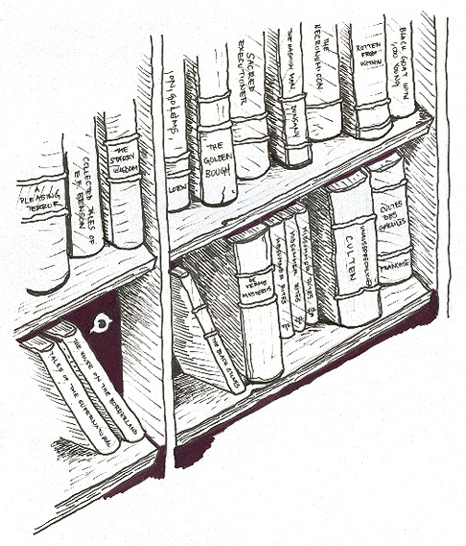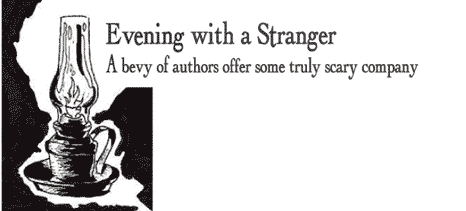|
Words & illustration by Eric
Reitz
With wintry nights lengthening and daylight
at a minimum, the frigid Cleveland December beckons you to
indulge in a nocturnal literary excursion. Move your chair
closer to that roaring fire, snuggle under the duvet, or station
yourself in a cozy reading room. Now crack open that musty
old tome and step back through decades passed.
These English authors
share a sensibility far removed from our own lightning-paced
realm. Atmosphere and ambiguity are crucial, fear is inevitable,
and blood and guts are minimal. Find yourself in the grip
of a classic ghost story or a charmingly weird tale.
With a pantheistic reverence and a body of work
that includes a staggering 200 short stories, Algernon
Blackwood (1869-1951) is a tower of strength in the
horror/weird tales genre. From the swamplands of the Danube
to the unexplored Canadian wilderness settings, his accounts
are rife with ancient sorceries, spiritual terror and deep
metaphysical leanings. A reporter, adventurer and member of
the occult society called The Golden Dawn, Blackwood's endless
curiosity about the inner workings of the soul informed a
vast number of his tales, imbuing them with an almost magical
charge.
The great outdoors in a Blackwood tale is presented,
for better or worse, as a force of transformation—displaying
his keen belief in the existence and activity of powerful
nature spirits. John Silence, a psychic detective, and a character
clearly modeled on Blackwood himself, visits villages across
Europe and solves inexplicable events such as local townspeople
transforming into felines during an unholy Sabbath.
Recommended reading: The
Wendigo, The Willows, The Man Whom the Trees Loved, The Empty
House (short stories, all).
++++++++++++++++++++++++++++++++++++++++++++
Another member of The Golden Dawn, one-time
decadent and occasional journalist, Arthur
Machen (1863-1947) produced more than 40 tales of the
supernatural and a handful of novels. His lyrical and Baroque
style successfully conveys a sense of cosmic horror in conjunction
with an obvious fear and respect for pagan deities.
Several of his stories are steeped in esoteric
lore and faint eroticism, providing a counterpoint to the
pastoral, evocative descriptions of the rolling Welsh countryside
and the quaint, primitive peoples inhabiting these lands.
Like many protagonists in weird tales, the curious are often
punished by atavistic powers, resulting in what many consider
highly moral cautionary tales.
Recommended reading: The
Great God Pan, The Inmost Light, The Novel of the White Powder,
The Novel of the Black Seal (short stories).
++++++++++++++++++++++++++++++++++++++++++++
Though better known for his whimsical PBS fodder
"Mapp and Lucia", E. F.
Benson (1867-1940) produced an extraordinary number
of works dealing with the very traditional ghost story, or
"spook story" as he referred to them.
The son of The Archbishop of Canterbury and
a three-time mayor, Edward Frederic Benson's stories often
focused on the activities of upper-class people of leisure.
Benson embarks them on holidays to cozy country estates that
just happen to be plagued by malevolent spirits and fiendish
creatures.
His characters' encounters with dread revenants
occasionally seem too easily dismissed by the presence of
an almighty positive force (invocation of God's name, for
example), but atmosphere is present in abundance.
It seems quite evident from several of these
encounters that Benson had a humorously severe aversion to
slugs and caterpillars.
Recommended reading: The
Man Who Went Too Far, Gavon's Eve, Negotium Perambulans, How
Fear Departed from the Long Gallery (short stories).
++++++++++++++++++++++++++++++++++++++++++++
Provost of King's College, Cambridge, and Eton,
M. R. James (1862-1936) is
considered by many to be the unofficial Father of the Modern
Ghost Story. His approximately 40 ghost stories are exquisitely
and, alas, sometimes ponderously detailed, presenting extended
histories of cathedrals, tracts of land, trials and turn-of-the-century
customs. Nosy antiquarians are in surplus, not surprising
given James’ background as a medieval scholar. Hapless
protagonists stumble upon the odd 'nameless evil', or uncover
an artifact that is inextricably linked to some vengeance-seeking
ghoul. No one is safe from harm in his work; the innocent
and the guilty alike are the unwitting prey for damage and
death.
Recommended reading: Oh
Whistle and I'll Come to You, My Lad; Casting the Runes; Count
Magnus; Canon Alberic's Scrapbook (short stories).
++++++++++++++++++++++++++++++++++++++++++++
Lesser known than the previously mentioned authors
but certainly deserving of praise is William
Hope Hodgson (1877-1918), an author, sailor, and bodybuilder
killed during World War I. With four novels and 30 tales of
supernatural horror and nautical adventure, he produced his
entire output within a period of 11 years.
Like Blackwood's John Silence, Hodgson imagined
many terrifying scenarios for his 'spiritual investigator',
Carnacki the Ghost Finder. Running into unexplained phenomenon
in addition to pranksters and misfits masquerading as bogeymen,
Carnacki was clever and skilled in occult matters, but not
necessarily brave when faced with danger.
Hodgson's masterpiece is The House on the Borderland,
a short novel that is thoroughly gripping in its depiction
of primal creatures and cosmic phenomena.
Recommended reading: The
House on the Borderland, The Voice in the Night, The Whistling
Room, The Gateway of the Monster (short stories).
The works of these authors are readily
available through Clevenet Libraries, specialty bookshops
and, yes, even those big box chain stores. Please patronize
small businesses when possible. Purchasing First Editions
will likely result in your bankruptcy. Spread the word.

Bruce home
| 




